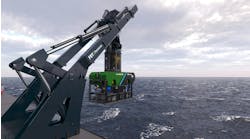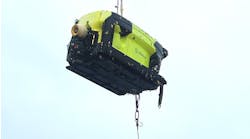Gene Kliewer • Houston
More Ormen Lange work commissioned
Acergy SA has been awarded a $58-million contract from StatoilHydro on behalf of the Ormen Lange Licences. The contract is for the installation of a MEG line and umbilical, and tie–in and commissioning of the MEG line, umbilical, and flowlines in a water depth of 900 m (2,953 ft) on the Ormen Lange Southern field development project. Offshore installation will start 2Q 2009.
Lowering of an Ormen Lange subsea template in the Norwegian Sea.
“We welcome the award of another deepwater construction contract for StatoilHydro for additional work on the Ormen Lange field, which follows the installation of the export trunkline in 2006 and the MEG line work completed earlier this year,” says Oeyvind Mikaelsen, vice president Acergy Northern Europe and Canada.
Saudi moves keep offshore construction moving
Saipem has been awarded $700 million in new contracts for work offshore Saudi Arabia and Spain. Saudi Aramco has signed with a consortium of Saipem and its Saudi Arabian partners Taqa and Al Rushaid for construction, transportation, and installation of offshore facilities in the kingdom, aimed at maintaining the country’s oil production capacity (Maintain Potential Facilities Program). The agreement is for seven years, plus two three-year options, and encompasses the engineering, procurement, construction, transport, and installation of offshore platforms and pipelines.
During the first four years of the agreement, a minimum workload is guaranteed consisting of 16 platforms and 80 km (48 mi) of sea lines, in addition to the lay of the cables, ancillary to the platforms. Saudi Aramco periodically will confirm the scope of work valued on the basis of a “price-per-unit” agreed plan.
Fabrication will be done in a yard under construction in Dammam, Saudi Arabia, while the offshore activities will be performed by theCastoro II.
Saudi Aramco is expected to issue the first plans and budget allocation in 4Q 2007.
Petrobras active at home, in GoM
Petrobras has completed more than 100 days of operating its Jubarte field subsea centrifuge pumping system and says the project increased oil production at the JUB-6 well from 10,000 b/d to 24,000 b/d.
The pumping system is part of Petrobras’ Heavy Oil Technology Program. The Submarine Centrifuge Pumping System consists of a downhole centrifuge pump connected to the subsea tree and piping connections to platform P-34. The equipment will be monitored through year-end with an expected useful life of two years.
Plans are to install another, more powerful system in Marlim Leste field. The initial system is powered by a 4 kV motor; the Marlim Leste installation is to get a 7 kV motor.
The technology was a joint development of Cenpes, Petrobras’ E&P Production Engineering, and Espirito Santo (UN-ES) Business Unit.
In addition to its application in large accumulations to raise the oil recovery factor, Petrobras says the system can be used to make commercial production viable at smaller or marginal fields previously deemed noncommercial.
“There are great perspectives for this technology to be used, considering the large number of deepwater reservoirs in the Brazilian continental platform,” says Marcos Pellegrini, project coordinator from Petrobras’ Research Center. “And the most important fact is that a few of them are of marginal dimensions, which, to be made viable, require interconnection to satellite wells that are very far away from the production facilities and demand high-power pumping.”
While on the topic of Petrobras, its Americas subsidiary has awarded a $65-million contract to Aker Kværner to supply 70 km (43.5 mi) of high voltage power cables plus static and dynamic steel tube umbilicals for the Cascade and Chinook subsea developments in the Gulf of Mexico’s Walker Ridge area. The power cables and umbilicals are to be installed in 8,800 ft (2,700 m) water depth. The umbilicals are to be Aker Kværner’s carbon fiber rod technology.
The project management, engineering, and manufacturing will be at Aker Kværner Subsea’s facility in Mobile, Alabama. The scope of work includes design, qualification, fabrication, and testing of the umbilicals along with all required topside and subsea terminations. Delivery of power cables and umbilicals is scheduled for mid-2009.
Subsea wet gas compressor tested
Man Turbo AG has successfully tested a wet, acid gas compressor suitable for subsea applications. The Hofim compression system is an encapsulated design with an integral high-speed motor. The equipment now will under go further testing. Man Turbo and StatoilHydro are acting on behalf of the Åsgard License Partners to conduct the qualification program aimed at producing a complete system qualified for subsea compression.
The StatoilHydro K-Lab will lead the next phase of the program to investigate the long-term behavior of the system on different operating conditions.
With a target of 2013 to have the system in commercial application, Man Turbo says the big innovation in the current version is its compatibility with sour and wet gasses




